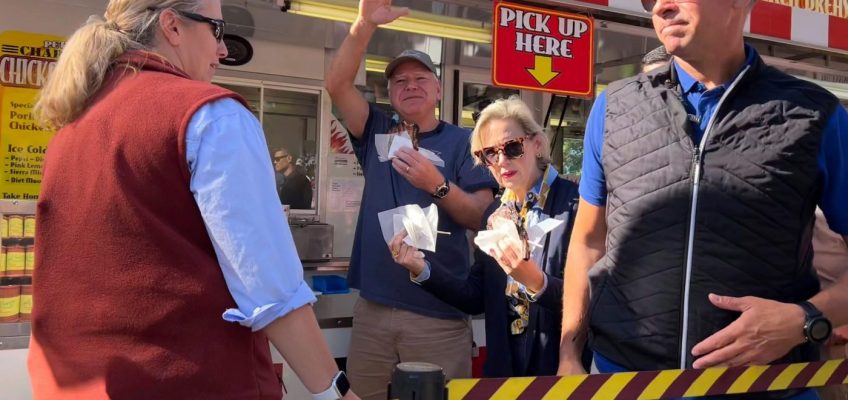For Gov. Tim Walz of Minnesota, August was a dizzying climb to the highest echelons of politics. Since being selected as Vice President Kamala Harris’s running mate, he has been the featured guest at glitzy private fund-raisers, flown to more than a dozen states and headlined a night at the Democratic convention in Chicago, with thousands in the arena hanging on his every word.
On Sunday, Mr. Walz was back in more familiar territory: the Minnesota State Fair.
He chomped on a pork chop on a stick. He admired the dairy princess butter carvings. He handed out ice cream at the Dairy Goodness Bar counter and waved at the crowd, which was eager for a glimpse — or a selfie — with the governor, who, for once, got to eschew the formal suit and tie for his more comfortable T-shirt and Carhartt pants.
It could have been just another one of Mr. Walz’s many state fair appearances over the years, where he has burnished his profile as an approachable Midwestern dad by wearing socks with a corn-dog pattern and riding the Slingshot, a nausea-inducing ride, with his daughter, Hope Walz.
Except for the presence of the Secret Service. And the motorcade that whisked him to and from the fair. And the officers stationed on the roof of the dairy building for an aerial view of the crowd, which was clamoring to see the man who has a chance this November to complete a meteoric rise from little-known Midwestern governor to vice president.
Mr. Walz, clutching a vanilla milkshake, acknowledged the obvious: Things were different this year.
“A little bit more of a disruption,” he told reporters, noting that he had to cut down from his usual 12 days of appearances. “But it’s exciting — I think people are seeing that we’re getting to talk about Minnesota across the country.”
Indeed. Supporters of Mr. Walz were bursting at the seams one after another, echoing Minnesota state pride as they waited to greet the governor with the enthusiasm of concertgoers meeting their favorite rock star. People from 50 states and 36 countries bought tickets to this year’s fair, according to Keri Huber, an archivist at the fair. Many of them grew up in Minnesota and return home annually for what is affectionately known as the Great Minnesota Get Together.
“We’ve never had this big of a politician come here,” Brittney Arnold, the manager of the Dairy Goodness Bar and the All You Can Drink Milk Stand, said before Mr. Walz arrived behind the ice cream counter. She clarified: Mr. Walz had come by as governor, but it wasn’t quite like this. “We’re really excited to showcase dairy,” she said.
Leslie Beller of Minneapolis was in line with her husband, Tyler, and their three children, when Mr. Walz began serving ice cream.
“I’m really proud to have Tim represent our state,” Ms. Beller said as her daughter, Charlotte, licked her vanilla cone. “He’s such a real person, he’s just one of us.”
The person who gave you ice cream, Mr. Beller said to Charlotte, “makes sure you get meals at school.” (Last year, Mr. Walz signed a bill for universal free school meals.)
“He’s the best of any choice there could have been, but I still need to see a lot more,” Mr. Beller added. “I want him to move to the left versus capitulate to the right.”
Down the street, Gwen Walz, the governor’s wife, and Hope Walz worked at one of the fair’s more iconic booths: Sweet Martha’s, home of warm chocolate chip cookies. They put on Sweet Martha’s hats and washed their hands at the direction of Martha Rossini — yes, Sweet Martha herself.
The governor’s wife has come to the state fair since she was a little girl, often with her grandparents, she said, and she and Mr. Walz visited every day when he was running for the House of Representatives and the governor’s seat. There was more freedom of movement then, she said.
She classified this year’s trip as “a more narrow experience.”
“I’m sticking with my faithful,” she said behind the tray of cookies. “I’ve volunteered in the Sweet Martha’s booth before, so I’m like, ‘I want to do that this year.’”
It was not entirely Minnesota Nice on Sunday. Republicans at a state party booth and a nearby “Never Walz” tent — where passers-by could spin a wheel filled with various right-wing refrains against the governor, such as “burning Minneapolis” and “stolen valor” — griped about his visit and his candidacy.
“We had to wait for his stupid motorcade before we could even get in the state fair,” said Jerrel Flanagan, 52, who lives in Mankato, Minn., where Mr. Walz taught social studies and coached football several decades ago.
“He’s a disgrace to Mankato,” Mr. Flanagan said. “He screwed everything up for Minnesota — the taxes are too high.”
Bill Nichol, a volunteer at the Republican Party stand, said he had seen the mood of the fair shift with the Walz family’s arrival.
“I’ve watched the Democrats walk with their heads held up a little higher than normal today, I’ll tell you that,” he said.
Lisa Hellerud-Recksiedler, a volunteer at the “Never Walz” booth, which sprung up years ago, said interest was especially high this year. The booth — sponsored by the conservative group Action 4 Liberty — is aiming to “get the word out about Tim Walz’s very liberal, damaging policies,” she said.
Despite the fact that their governor could become the vice president, many Minnesotans at the fair on Sunday had a more quaint concern: that Mr. Walz, with his suddenly busier schedule, might not get the chance to eat all his favorite foods at the fair, as he usually does.
David Dexheimer, 64, of Minneapolis said he was fervently hoping Mr. Walz would get his “must-eat” fair foods — everyone has a personal list, he added. “You have to have the cheese curds,” he advised.
For her part, Gwen Walz said she would have to miss the Hamline Dining Hall, a historic food concessions hall, and the Swedish soda burger, which she described as a meatball with wild rice, lingonberries and a sharp cheese.
On Monday, Mr. Walz will be back to the rough-and-tumble of the trail. His campaign said he would meet with labor leaders in St. Paul, Minn., before jetting off for Milwaukee.
But for one morning, at least, he got to be back on his home turf, soaking up the adoration.
Kevin Vargas was one of a number of attendees happy for Mr. Walz’s candidacy, but also coming to grips, with a tinge of sadness, with the fact that a Democratic victory in November would mean a new governor in Minnesota.
“It’s all bittersweet,” Mr. Vargas said. Mr. Walz has left a major mark on Minnesota, he explained, “but we are happy to share him with the rest of the country.”
Related Articles
It’s a pork chop on a stick and a vanilla shake for Tim Walz at the Minnesota State Fair
Trudy Rubin: Netanyahu’s betrayal of remaining hostages could drag U.S. into a regional Mideast war
Gov. Tim Walz to attend Minnesota State Fair on Sunday during a break in campaign stops
Letters: It’s our patriotic duty to become informed voters
Lawsuit filed for records about VP candidate Walz’s response to George Floyd civil unrest




